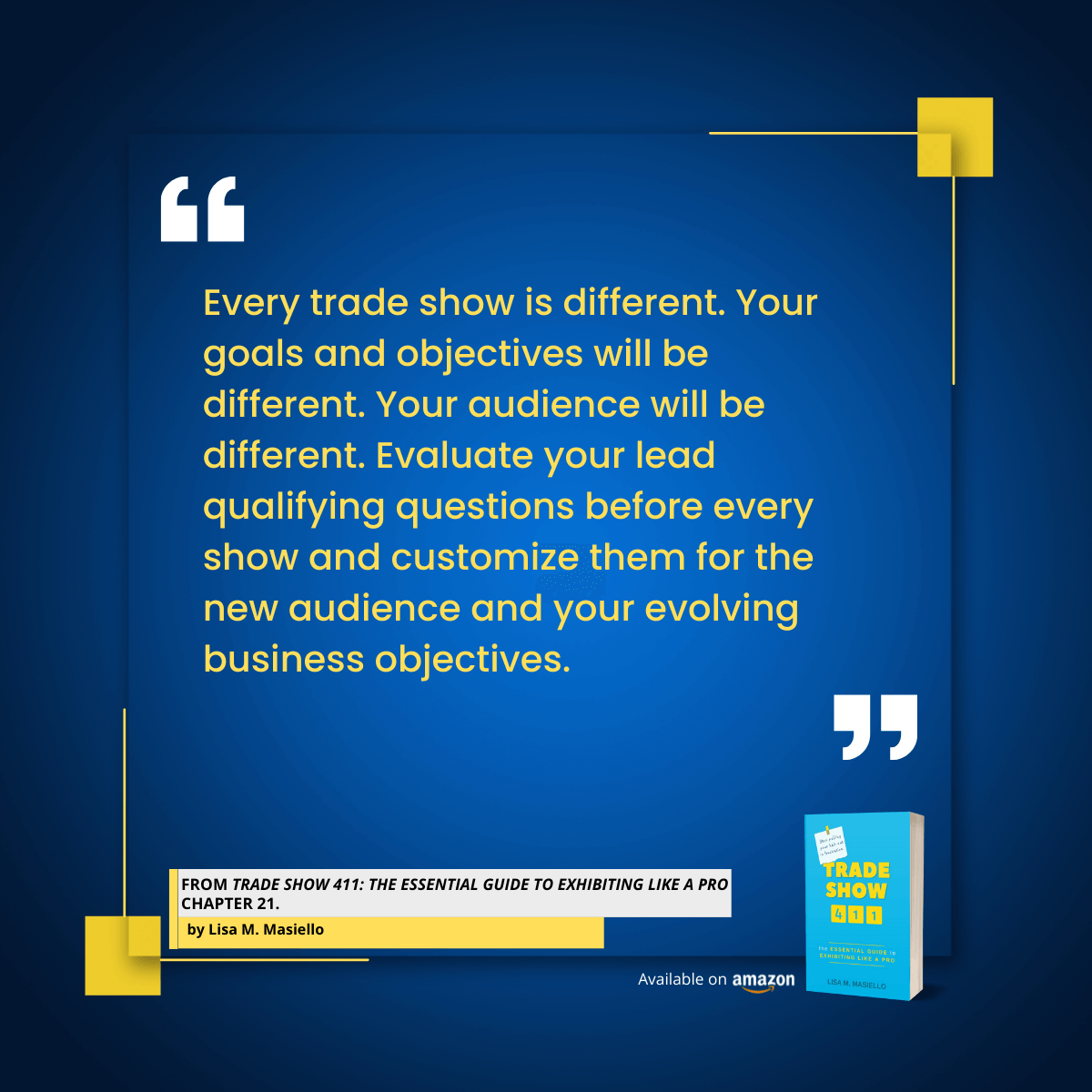7 Critical but Often Overlooked Expo Exhibitor Tips You Ignore at Your Peril
Written by Lisa M. Masiello
Whether you’re a young marketer just starting in your career, an experienced conference professional, or a small business owner trying to do it all, there are some expo exhibitor tips that you can't overlook – yet so many do. Keeping the following insights top of mind will help you deliver trade show results you can be proud of, and your management team will love.
Tip 1: Transportation options.
No matter how much you plan, there always seems to be product literature, tchotchkes, or something else that needs to be shipped overnight to your hotel right before your trade show begins.
I’ve often sent an item to myself at the hotel to ensure it makes it to the show on time.
There may also be last-minute graphics that require on-site printing because there's not enough time to print it near your office and ship it 2,000 miles to the convention center. That has certainly happened to me.
When considering what transportation you will use in the show city, it’s easy to forget about the items you shipped to your hotel or the large graphic you need to pick up from a local printer.
If you have to move boxes from your hotel to the convention center or carry an oversized poster from a print shop to your booth, how will you get them there?
You can throw two boxes of literature into the back of an Uber or taxi, but an 8 ft. sign won’t fit very well.
Tip 2: Understanding drayage.
I'll admit it. When I managed my first trade show, I thought drayage was the same as shipping. Or at least that drayage is included as part of the shipping cost. After receiving my post-show shipping invoice and a separate drayage invoice that sent my actual budget through the roof, I quickly realized this was not the case.
Shipping expenses include:
The movement of your booth, collateral, signage, and other materials from your company's office or the exhibit house to the show's advance warehouse or the convention center's loading dock before the show begins.
The shipment of your materials from the show’s loading dock back to your office, exhibit house, or any other location after the show is over.
Drayage expenses include:
Processing of paperwork enabling your booth and materials to enter and leave the convention center or expo hall.
The physical movement of your booth, collateral, signage, and other materials by the general service contractor’s staff from the loading dock or another delivery location to your booth space before the show begins and back to the loading dock after the show is over.
The movement of empty boxes and crates from your booth to the holding area or boneyard for storage during booth installation.
The delivery of any packages to your booth while the show is taking place.
Don't make the same mistake as me. When creating your exhibitor budget, include a line item for shipping and a separate line item for drayage.
Tip 3: Lead management.
When thinking about what questions you should ask booth visitors to help determine if they are a sales qualified lead, a marketing qualified lead, or a prospect that needs to be added to a nurture campaign, keep in mind that every show is different.
Your goals and objectives will be different.
Your audience will be different.
Evaluate your lead qualifying questions before every show and customize your questions for the new audience and your evolving business objectives.
For example, a software company exhibiting at a trade show of end-user business professionals may ask questions about how the attendees use the software as part of their daily business tasks, what outcomes they are looking for, and what challenges they are trying to overcome.
The same software company exhibiting at a trade show of technical professionals like system administrators and IT managers will ask questions about their software ease of installation, management, network integration, data storage, and security requirements.
Tip 4: Food and beverage distribution.
Today’s trade show exhibitor is expanding beyond simply offering a bowl of mints, hard candies, or party-size chocolate bars to handing out oversized cookies, large popcorn boxes, specialty coffee, and even beer and wine.
The food or drinks you offer can positively impact attendees, but you should be aware of the rules if you decide to distribute them. You must inform the show's approved caterer of your plans.
Your exhibitor services manual includes a catering section that discusses the rules for food distribution in your booth, if you will need to hire separate staff from the show's exclusive caterer, and how much it will cost.
Realize that any exhibitor handing out food or drink is a competitor to the expo hall's food concessions and the catering department, taking away potential revenue from them by you giving out complimentary refreshments to attendees. These complimentary refreshments can include any food and drink, from small bags of peanuts or bottled water to a full bar and hors d'oeuvres.
Some exhibitors will take a chance and not inform the show caterer, willingly paying a fine if they get caught. While receiving a small fine is possible, you can also find your booth shut down for the show's duration. It’s not worth the hassle, embarrassment, and loss of potential revenue if your booth is closed for not following the rules.
Tip 5: Current customer value.
Trade show and conference participation give you the unique opportunity to interact with both potential customers and current customers.
As 50 percent of your company's sales equation, existing customers are essential to market to, upsell and cross-sell to, and share some love with while you are at the show.
Current customers are more likely to buy additional products and services from you on-site at the show or shortly after it is over. This condensed sales cycle enables you to drive immediate sales while waiting to close new deals with long-term prospects and new show leads.
Never ignore this valuable opportunity to engage with and sell to current customers who already know and love you while introducing your business to new prospects.
Tip 6: Booth etiquette.
Please do not let anyone on your team sit down or eat lunch in your booth in full view of potential customers walking by. Whether you realize it or not, this sends absolutely the wrong message.
When potential customers see a staff member sitting or eating in your booth, they are thinking:
You are disinterested in what you are supposed to be doing.
You are tired.
You cannot be bothered with me—your potential customer.
Your comfort and your stomach are more important than the job at hand.
While these impressions may be inaccurate, they are natural. They'll cause the people you are trying to attract to keep walking and never interact with your team.
I'm certainly not saying that your employees should never take a break or eat anything until the show has ended for the day—quite the contrary.
When creating your staffing schedule, try and assign no more than four consecutive hours of booth duty per employee. Giving them time away from the booth to rest their feet, have lunch, and decompress a bit, will help them come back refreshed and ready to convert those trade show attendees into new customers.
Tip 7: Reserving next year's booth space now.
As an exhibitor, you need to make sure the trade show you select is right for your business.
Does it attract the correct type of attendees?
Is the expo hall open to booth visitors all day or just two hours a day?
Will the show generate a lot of booth traffic, or will most attendees be at the educational presentations and never make it to your booth?
If it is your first time exhibiting at a show, it's hard to decide whether the show will be a good return on your company's investment or not while it’s still going on. But this is a decision the show's sales team will want you to make while you are on-site before the show is over.
Go to the sales meeting they set up for you. Listen to what the salesperson has to say. Just make sure that you read the contract's fine print carefully. Cancellation policies vary from event to event, so discuss the policy with the sales representative before signing anything.
There are two types of cancellation policies:
Policy 1: This cancellation policy has a thirty-day opt-out clause, enabling you to cancel your contract up to thirty days after the current show is over without incurring any financial penalty.
Policy 2: This cancellation policy requires an up-front percentage of payment when you sign the contract. If you cancel any time after the contract is signed, you will receive X percent of your money back. Never the whole amount.
If you’re sure that you want to exhibit again next year, sign up during your sales appointment at the current show to receive your booth space for the next show. You will benefit from a discounted rate, and you will be able to select from a wider variety of available booth spaces.
If you are uncertain about next year's participation but can cancel without a financial penalty up to thirty days after the current show, sign up. Just remember, add a note in your calendar or a task to your to-do list within the month after the show has ended to evaluate your show’s results and finalize your decision on next year’s participation. You should have received your final bills for the current show and better understand your total cost by this time.
Evaluate this year's success and whether you want to exhibit again next year. If the answer is no, be sure to cancel that contract before the thirty days are up.
Other related posts
Filter by Category
About Lisa M. Masiello
Lisa M. Masiello is a business owner, author, and coach who equips new and aspiring business owners with practical tools and clear knowledge to break free from the stuck phase and make real progress. With over three decades of experience guiding fast-growing startups and large corporations in their marketing strategy, she knows what it takes to build momentum and deliver results.








